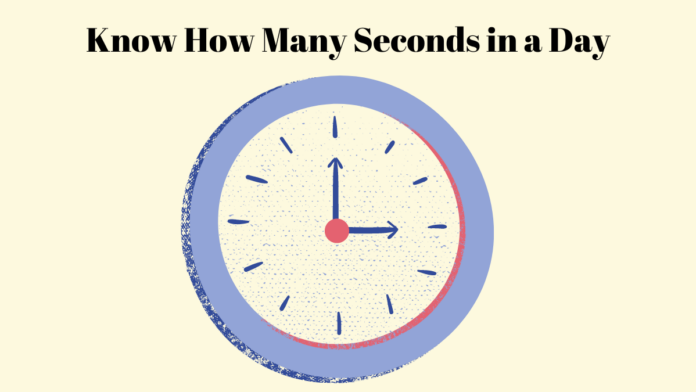Have you considered how many seconds there are in a day? Knowing this can change the way we think about and use our time.
This article will explore the history of time tracking, the total number of seconds in a day, and how to calculate this number.
From our studies, we will share knowledge about how people have kept track of time over the ages. Also, you will get to know how many seconds in a day are there and much more about it:
What is a Second?
A second is the basic unit of time. It is the time it takes for 9,192,631,770 transitions between two specific energy levels in a caesium-133 atom. Scientists around the world use this as the fundamental time measurement.
How Many Seconds in a Day?
There are 86,400 seconds in a day. We get this number by multiplying the 24 hours in a day by the 60 minutes in each hour, and then by the 60 seconds in each minute. So, 24 hours × 60 minutes × 60 seconds = 86,400 seconds.
What is an Atomic Clock?
An atomic clock is a precise timekeeping device that measures time using the vibrations of atoms. It relies on the different energy levels of atoms.
Accuracy of Atomic Clocks
These clocks are incredibly accurate, gaining or losing less than one second in a few million years. Their precision is crucial for applications like GPS and telecommunications.
How does the Atomic Clock Measure Time Intervals?
Atomic clocks measure time intervals by monitoring the vibrations of atoms, specifically the caesium-133 atom. Here is a simplified explanation:
- Oscillations: Atomic clocks are designed to count the precise length of a second by measuring the oscillations of caesium-133 atoms. A second is the time it takes for these atoms to oscillate exactly 9,192,631,770 times.
- Working Principle: The atoms are heated and bundled into a beam. Only atoms in a specific energy state (let us call it state A) are allowed through. These atoms pass through a resonator exposed to microwave radiation, causing some to change to another energy state (state B). The number of atoms that change states depends on the frequency of the microwaves. The goal is to tune the microwaves perfectly to the atoms’ oscillation frequency.
- Accuracy: Atomic clocks are incredibly accurate, with some losing or gaining less than one second every few million years. This precision is important for technologies like GPS and telecommunications.
- Leap Seconds: Occasionally, leap seconds are added to Coordinated Universal Time (UTC) to keep atomic time in sync with astronomical time, accounting for irregularities in the Earth’s rotation.
Rotation Speed & Day Length:
The time it takes for the Earth to spin once around its axis decides how long a day is. The speed of Earth’s spin can change because of different things, which means the length of a day changes too.
What Affects Earth’s Spin?
The pull of the moon’s gravity, the movement of the oceans, and shifts inside the Earth itself can make the Earth spin differently.
How Have Days Changed?
Over time, the Earth has been spinning more slowly, making days longer. This slowing down is mostly because of how the moon’s gravity pulls on the Earth. We have found that days used to be shorter, but they get longer as time passes.
Dennis D. Conceptualization
A famous expert on how we think about time, Dennis D., has studied how people understand and experience time daily. His research shows how important it is to know that our view of time can be affected by our culture, where we are, and our differences.
By calculating 24 hours times 60 minutes times 60 seconds, we have 86,400 seconds daily. The way we keep track of time has changed a lot, from old sundials to the atomic clocks we use now.
As we learn to value the exactness of our clocks and watches, we also learn more about the complicated nature of time and what makes the Earth spin.
It is important to know that the Earth spins at different speeds, which can change the length of a day. Also, having leap years and seconds helps keep our calendars and clocks correct.
Some Questions
How Many Seconds in a Day?
There are 86,400 seconds in one day.
How do you calculate the seconds in a day?
You multiply the number of hours in a day by the number of minutes in an hour and then by the number of seconds in a minute. So, it is 24 hours × 60 minutes × 60 seconds, which equals 86,400 seconds.
Why do we count 24 hours in a day?
A day is the time it takes for the Earth to make one full rotation on its axis, and we have divided this period into 24 equal parts, called hours.
Can the number of seconds in a day ever change?
Generally, the number of seconds in a day stays the same, but sometimes we add a leap second to keep our clocks in sync to the Earth’s rotation.
What is a leap second?
A leap second is added to Coordinated Universal Time (UTC) to adjust for small changes in Earth’s rotation speed.
Are there exactly 86,400 seconds in every single day?
Almost always, but not always. Due to the leap second adjustment, some days might have one extra second.
How does an atomic clock measure a second?
An atomic clock measures a second by counting the number of specific vibrations of caesium-133 atoms. It is very precise and is used as the standard for timekeeping.















